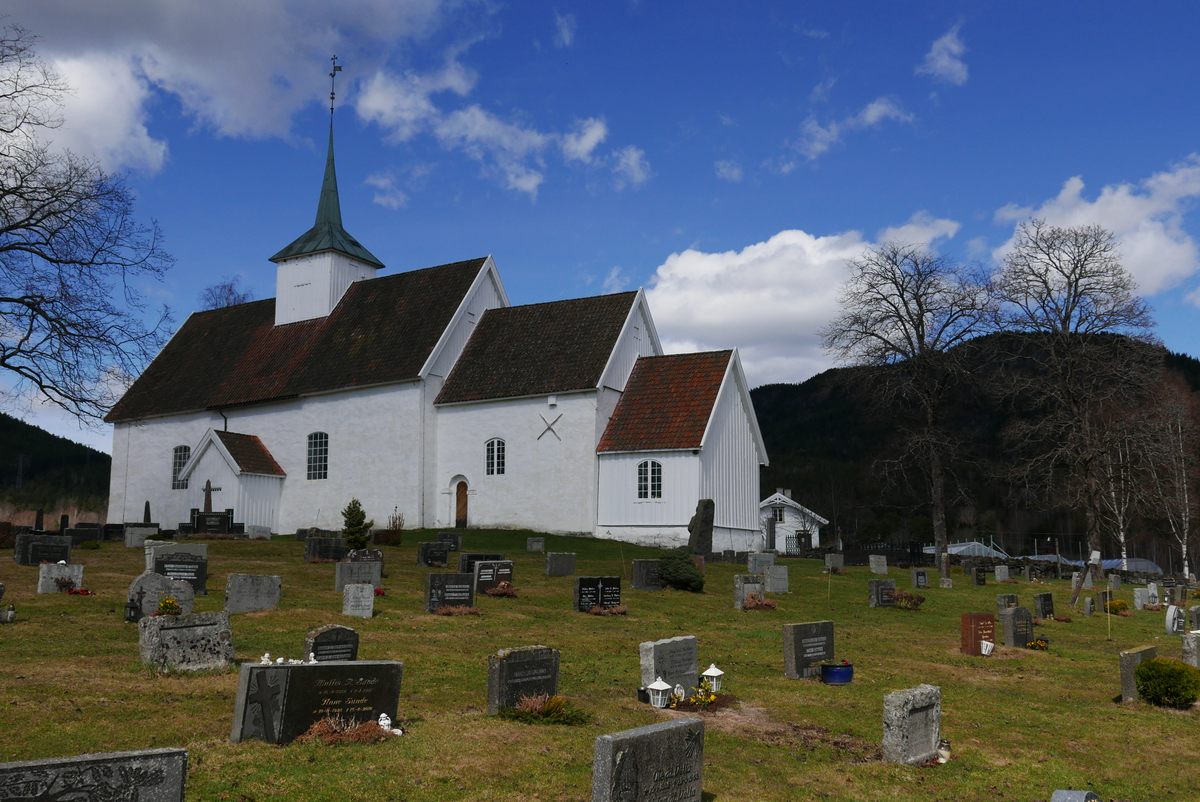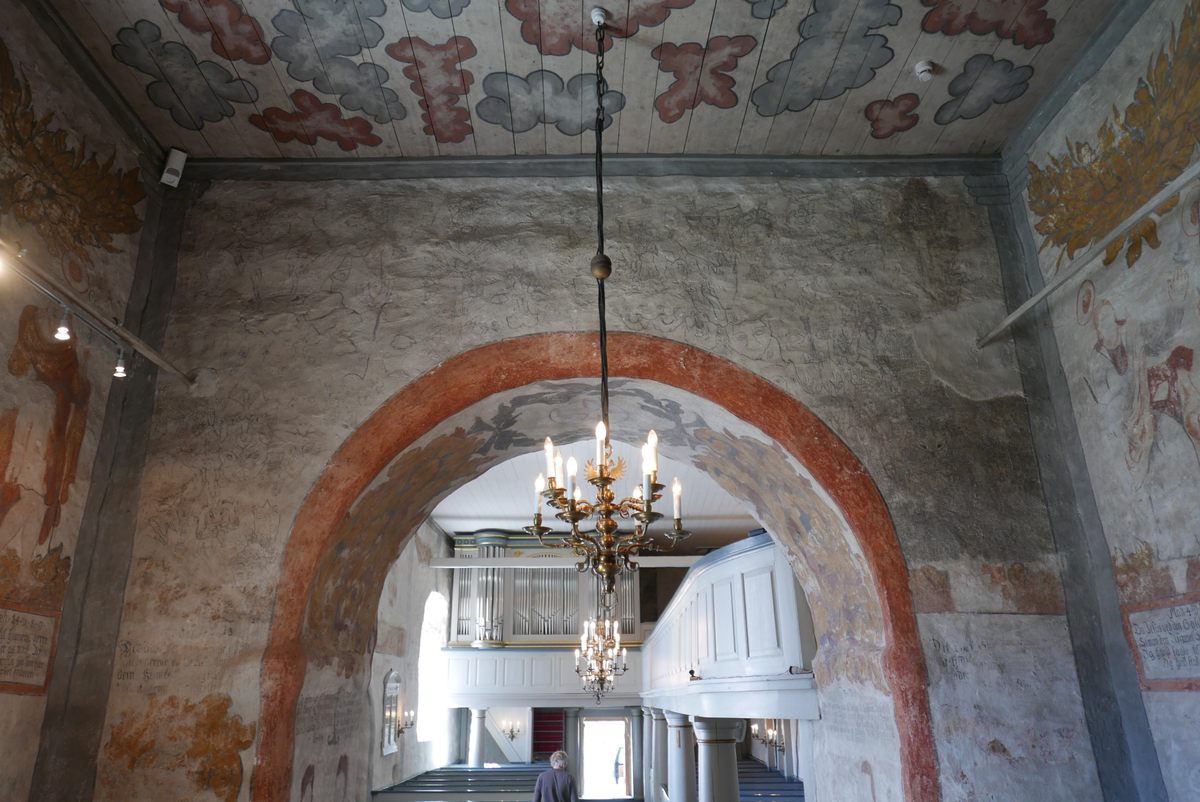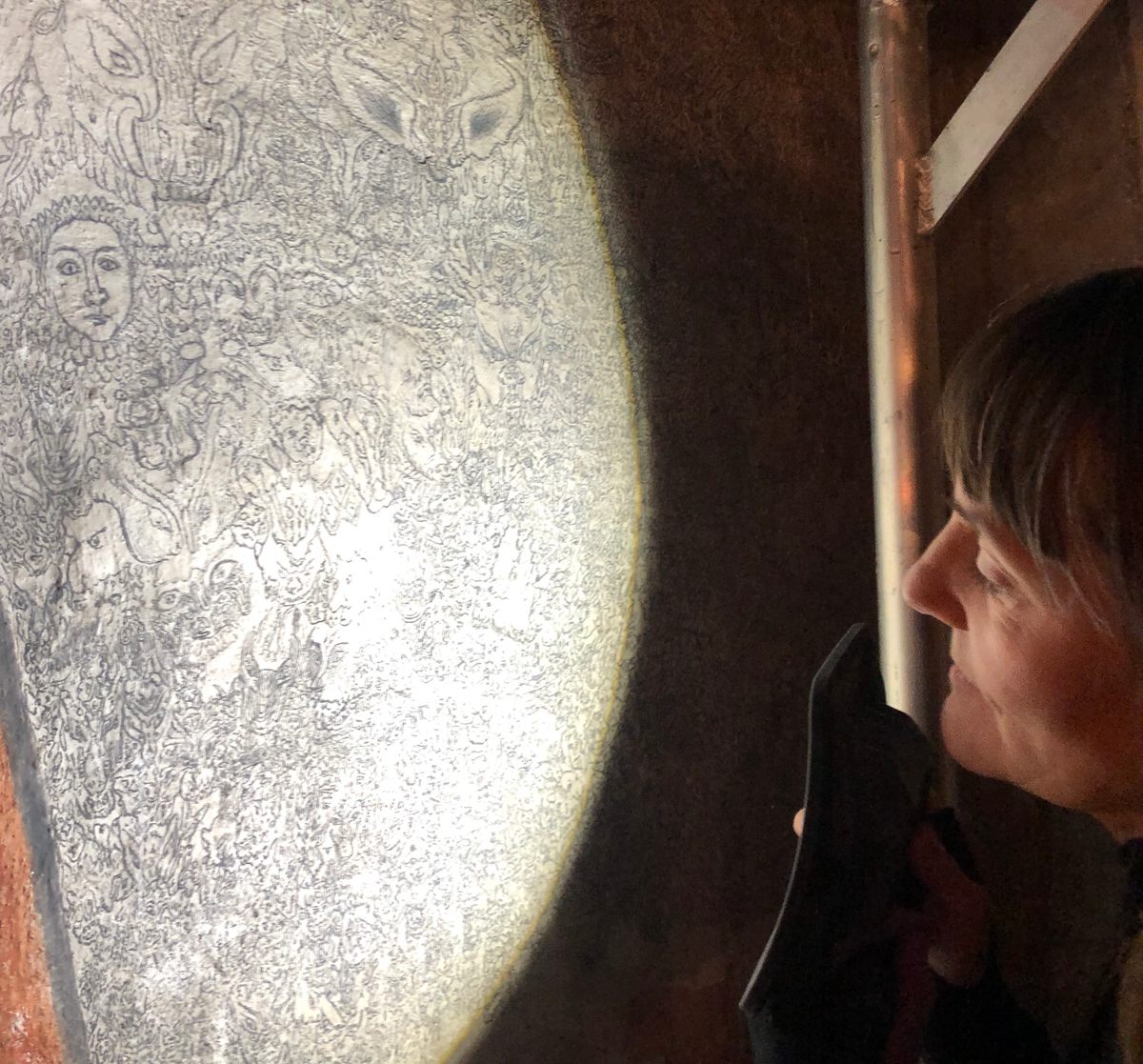
The Curious Case of Norway’s Disturbing Demon Wall
A respected conservator restoring a centuries-old church mural saw the devil in the details—and created a wholly imagined, diabolical scene.
The demons are tiny, and legion. Scowling, tongue-flicking devils, no bigger than a thumbnail, and strange animals pile together in a tangle of dog legs and rabbit ears, each smaller than the next. The lines of the painting are so fine that the tiniest figures seem to pull the viewer into an infinite Satanic menagerie.
The story of how the demonveggen, or demon wall, came to be is as strange and disturbing as the mural itself. It’s a tale of scandal, fraud, and possible madness that begins with Gerhard Gotaas, one of Norway’s leading conservators of the mid-20th century. His work preserving and restoring medieval church art was wide-ranging and respected. But in 1940, when he entered a small village church in Sauherad to restore centuries-old artwork, he saw demons. Researchers determined earlier this year that, instead of reviving a 17th-century painting, Gotaas actually spent two years creating a monstrous mural from his own imagination. That revelation is just part of the story, however. Scant and contradictory clues only deepen the mystery of what might have possessed him to create the hellish image.
“We couldn’t believe it. We were shocked by how much he really did,” says Susanne Kaun, a conservator at the Norwegian Institute for Cultural Heritage (NIKU). Kaun undertook the demon wall investigation with her colleague, art historian Elisabeth Andersen. Through archival research and scientific analysis of the mural itself, the team discovered not only that Gotaas invented the demons, but also that he destroyed all remnants of the original art, painted more than 300 years earlier. “That’s really the most shocking thing, from a conservator point of view,” says Kaun. “He found something there that was old, and he painted over that. He changed what he found. He has to have known what he did.”

The church, in southern Norway, was built almost 900 years ago. It sits just west of the Saua, a minor river that connects two of the Telemark region’s many lakes. The church itself looks out onto tidy farms and thickly forested hills, a landscape little changed since the late-16th or early-17th century, when a mural was added to the chancel. Kaun and Andersen found an archival photo that shows traces of what appears to be the head of a Biblical figure on one part of the wall. The photograph was taken years before Gotaas took up his tools and brushes and irrevocably changed it: “The eyebrows became like animals with 10,000 legs and heads at each end, the beard became all heads with ears,” says Andersen. Based on other, larger demon heads on the wall, Andersen and Kaun think Gotaas may have painted over two or three other original figures.
The question, of course, is why. Gotaas had conducted numerous restorations all over Norway before and after this project, including additional work at Sauherad Church. He also completed other assignments during the same two-year period he spent working on the demon wall: The unheated village church was too cold for winter work, so he turned his attention elsewhere for weeks and months at a time. None of the other work from that time—or the rest of his career—is considered problematic. In 1944, art historian Harry Fett, then the director of the country’s cultural heritage management agency, even lauded the “excellent work” Gotaas did in restoring the mural. Anyone who has seen the demons up close might raise an eyebrow over Fett’s praise, but the truth is, most people—Sauherad’s congregation, church visitors, and likely Fett himself—haven’t experienced the demon wall as Gotaas envisioned it.
The mural occupies a stretch of arched wall in the chancel that’s about eight to 12 feet above the floor. It’s on such a fine scale that, “when you stand on the floor and look up, it’s like a gray cloud. It looks dirty on the wall,” says Andersen. “It’s impossible for a visitor to see the details, how strange and fascinating it is … It’s chaotic, and it’s so, so small, a figure in a figure in a figure.”

But almost immediately after Gotaas unveiled it, say Kaun and Andersen, there were whispers about its authenticity.
“Our older colleagues had heard all these rumors,” says Andersen. Gotaas, according to the grapevine, had taken too much artistic license at Sauherad. But with Norway reeling from German occupation during World War II, destructive bombing raids, and rationing, the country had more pressing concerns than a suspicious restoration project in a country church. The demon wall slipped into obscurity—or was pushed there. “They put a lid on the whole story,” says Andersen. “It was a scandal that the government had paid for it and supported it.”
A decade later, with a new director at the culture heritage agency, additional restoration was carried out at Sauherad, but, says Andersen, “They never mention the demon wall. We cannot find it in the archives.”
For years, Sauherad’s demon wall remained a minor curiosity, little studied and never explained. Then Kaun and Andersen saw a new generation of art historians starting to take interest in what they believed was a centuries-old mural with a peculiar theme and style. “There are younger people in their 20s and 30s who want to write about it but they don’t know what we know, because they haven’t talked to the older people we had talked to,” Kaun says.
When the two colleagues embarked on a broader study of church murals, they knew Sauherad had to be one of their subjects. “We had to make the story right,” says Andersen.

Some things were apparent to Kaun from the first moment she climbed the scaffolding for a closer look. She says that Gotaas wrote early in the project that he was following incised lines left behind by the original painter. “It’s not really possible to leave that kind of incision,” Kaun says. “It’s too small.” Additional analysis using UV light, magnification, and other methods confirmed that the restoration was actually a fabrication. Stylistically, the mural is also unlike anything seen in centuries past, both in scale and theme. While demons and devils do appear frequently in church art the world over, they do so as characters in a larger story told across the space. The demon wall, however, “is just chaos. It’s not anything,” says Kaun.
Psychologist Ellen Winner, a retired Boston College professor and author of How Art Works: A Psychological Exploration, does see something in the demon wall—and finds it perplexing. “As soon as I saw it, I said ‘This looks like schizophrenic art,’ which is characterized by what’s called horror vacui, or a horror of empty space,” says Winner. She was not involved in the analysis of the mural but has viewed images of the artwork.
What’s puzzling is that there is no indication that Gotaas had schizophrenia or any similar condition. Letters and other documents he wrote suggest he was lucid throughout his career, including during the period he worked at Sauherad. “Prose is very sensitive to thought disorders,” says Winner. “If you find someone who can write coherently, it’s pretty likely they don’t have a thought disorder.”

Kaun and Andersen had also searched for any evidence of mental illness or personal trauma, either in his writings or interactions with people in Sauherad, but found nothing remarkable. “He lived at the vicar’s house while he was working on the wall,” Andersen says. “We’ve spoken to people whose parents met him and they say he was a nice man.”
“It is possible that he had some kind of episode of mental illness that made him go down a deep, dark path,” says Winner, adding that, without hospitalization records or other documentation, “You can’t diagnose anybody that’s long dead.”
Gotaas undertook the Sauherad project with his son Per, who was then in his 20s and learning the conservator craft from his father. Kaun and Andersen do not think the demon wall is the work of the younger Gotaas, however. While the father was not the best record-keeper, the researchers note, he did document which area Per worked on, “the part with fewest figures,” Kaun says. “It looks like he tried to follow what the father said to do but he couldn’t see what the father saw.”
“We think the son had no part in this,” adds Andersen. Per Gotaas, now deceased, went on to have an uneventful career as a conservator. Without any evidence of mental illness in either father or son, deception of some kind seems more likely. And it would have been easy for Gotaas to pull it off. He worked at a time with few experts to critique his restorations, and with little oversight. “The cultural heritage director did not question how the conservator worked,” says Kaun. She adds that Gotaas “liked to say that restoration is a magic thing to do. He was not a scientific man.”

Gotaas also had a secretive work style that could have served as a cover for deception. “People said that he threw people out and closed the door and worked by himself,” says Anderson. While there is nothing to suggest the early conservator was a prankster, she admits that she looked for some sign that the demon wall was an elaborate practical joke. “We went centimeter by centimeter looking to see if he left some kind of message,” Andersen says. “I was hoping he was like, ‘Gotaas was here,’ because he knew he was doing something that went too far. But we couldn’t find it.”
The mere act of pulling off the fraud might have been reward enough, says Winner, who has studied the psychology of art forgery. “He could have said, ‘This is my chance to paint something that everybody’s going to look at, and even though they won’t know it’s me, I’m going to get a kick out of thinking about it,’” she says. “There’s a motivation forgers have, to trip up the art world, not only to show how great one is, but to confuse people.”
Kaun and Andersen have doubts that Gotaas intended to fool anyone. He was skilled enough to invent a credible fake in the style of a 17th-century mural. “If he wanted to deceive people, and make them think it was authentic, why make this?” Andersen asks. “I think he didn’t do it on purpose, he really tried to find something there and what he saw, what he painted, was what something in him saw. He went mad, in a way.”
As for the demon wall itself, it remains, hanging over the church’s chancel like a foreboding gray cloud of unanswered questions. “Now it’s also part of the history,” says Andersen, noting that the artwork, despite its ignominious origin and unnerving content, is now protected by Norway’s rigid cultural heritage laws.
For Kaun, the demon wall remains as much a professional abomination as a devilish mystery. “There is no reason for a conservator to change a painting he found,” she says. “It’s like painting a mustache on the Mona Lisa. You don’t do that.”

































Follow us on Twitter to get the latest on the world's hidden wonders.
Like us on Facebook to get the latest on the world's hidden wonders.
Follow us on Twitter Like us on Facebook